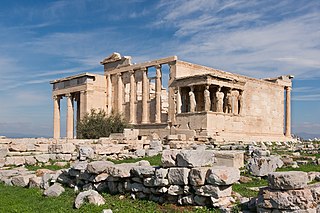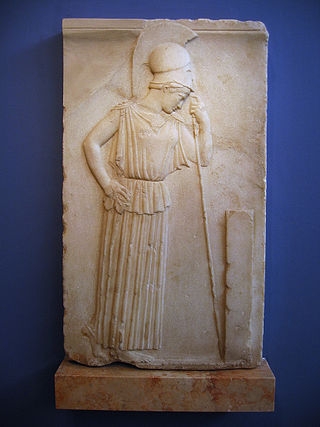
Athena or Athene, often given the epithet Pallas, is an ancient Greek goddess associated with wisdom, warfare, and handicraft who was later syncretized with the Roman goddess Minerva. Athena was regarded as the patron and protectress of various cities across Greece, particularly the city of Athens, from which she most likely received her name. The Parthenon on the Acropolis of Athens is dedicated to her. Her major symbols include owls, olive trees, snakes, and the Gorgoneion. In art, she is generally depicted wearing a helmet and holding a spear.

The Acropolis of Athens is an ancient citadel located on a rocky outcrop above the city of Athens, Greece, and contains the remains of several ancient buildings of great architectural and historical significance, the most famous being the Parthenon. The word Acropolis is from the Greek words ἄκρον and πόλις. The term acropolis is generic and there are many other acropoleis in Greece. During ancient times the Acropolis of Athens was also more properly known as Cecropia, after the legendary serpent-man Cecrops, the supposed first Athenian king.

The Parthenon is a former temple on the Athenian Acropolis, Greece, that was dedicated to the goddess Athena. Its decorative sculptures are considered some of the high points of classical Greek art, and the Parthenon is considered an enduring symbol of Ancient Greece, democracy, and Western civilization.

Fifth-century Athens was the Greek city-state of Athens in the time from 480 to 404 BC. Formerly known as the Golden Age of Athens, the latter part being the Age of Pericles, it was buoyed by political hegemony, economic growth and cultural flourishing. The period began in 478 BC, after the defeat of the Persian invasion, when an Athenian-led coalition of city-states, known as the Delian League, confronted the Persians to keep the liberated Asian Greek cities free.

The Panathenaea was a multi-day ancient Greek festival held annually in Athens that would always conclude on 28 Hekatombaion, the first month of the Attic calendar. The main purpose of the festival was for Athenians and non-Athenians to celebrate the goddess Athena. Every four years, the festival was celebrated in a larger manner over a longer time period with increased festivities and was known as the Great (or Greater) Panathenaea. In the years that the festival occurred that were not considered the Great Panathenaea, the festival was known as the Lesser Panathenaea. The festival consisted of various competitions and ceremonies, culminating with a religious procession that ended in the Acropolis of Athens.

The Erechtheion or Temple of Athena Polias is an ancient Greek Ionic temple on the north side of the Acropolis, Athens, which was primarily dedicated to the goddess Athena.

The Temple of Athena Nike is a temple on the Acropolis of Athens, dedicated to the goddesses Athena and Nike. Built around 420 BC, the temple is the earliest fully Ionic temple on the Acropolis. It has a prominent position on a steep bastion at the south west corner of the Acropolis to the right of the entrance, the Propylaea. In contrast to the Acropolis proper, a walled sanctuary entered through the Propylaea, the Victory Sanctuary was open, entered from the Propylaea's southwest wing and from a narrow stair on the north. The sheer walls of its bastion were protected on the north, west, and south by the Nike Parapet, named for its frieze of Nikai celebrating victory and sacrificing to their patroness, Athena and Nike.

A peplos is a body-length garment established as typical attire for women in ancient Greece by c. 500 BC, during the late Archaic and Classical period. It was a long, rectangular cloth with the top edge folded down about halfway, so that what was the top of the rectangle was now draped below the waist, and the bottom of the rectangle was at the ankle. One side of the peplos could be left open, or pinned or sewn together, with a type of brooch later called "fibula". In Latin and in a Roman context, it could be called a palla.

Arrhephoria was a feast among the Athenians, instituted in honor of Athena. The word is derived from the Greek term Ἀρρηφόρια, which is composed of ἄρρητος, "unspoken, not to be divulged", and φέρω, "I carry". This feast was also called Hersiphoria, from Herse, the daughter of Cecrops, on whose account it was established.
An Arrephoros was a girl acolyte in the cult of Athena Polias on the Athenian Acropolis. They were seven to eleven years old. According to Pausanias, two Arrephoroi lived for a year on the Acropolis and concluded their term with a mystery rite called the Arrhephoria: they carried unknown objects into a cavern, and there exchanged them for other unknown objects.

The Old Temple of Athena or the Archaios Neos was an archaic Greek limestone Doric temple on the Acropolis of Athens probably built in the second half of the sixth-century BCE, and which housed the xoanon of Athena Polias. The existence of an archaic temple to Athena had long been conjectured from literary references until the discovery of substantial building foundations under the raised terrace between the Erechtheion and Parthenon in 1886 confirmed it. While it is uncontroversial that a temple stood on the central acropolis terrace in the late archaic period and was burnt down in the Persian invasion of 480, nevertheless questions of its nature, name, reconstruction and duration remain unresolved.

In Greek mythology and ancient religion, Nike is the goddess who personifies victory in any field including art, music, war, and athletics. She is often portrayed in Greek art as "Winged Victory" in the motion of flight; however, she can also appear without wings as "Wingless Victory" when she is being portrayed as an attribute of another deity such as Athena.
The Chalkeia festival, the festival of Bronze-workers, was a religious festival devoted to the goddess Athena and the god Hephaestus. It was celebrated on the last day of Pyanepsion. The festival celebrated Athena and Hephaestus, in honor of both gods as patron deities of Athens, and as deities of handicrafts.

Joan Breton Connelly is an American classical archaeologist and Professor of Classics and Art History at New York University. She is Director of the Yeronisos Island Excavations and Field School in Cyprus. Connelly was awarded a MacArthur Fellowship in 1996. She received the Archaeological Institute of America Excellence in Undergraduate Teaching Award in 2007 and held the Lillian Vernon Chair for Teaching Excellence at New York University from 2002 to 2004. She is an Honorary Citizen of the Municipality of Peyia, Republic of Cyprus.
Plynteria was a festival of ancient Greece celebrated at Athens every year, on the 22nd of Thargelion, in honor of Athena Polias, with the heroine Aglauros, whose temple stood on the Acropolis. The festival's name came from plynein (πλύνειν), a Greek verb meaning "to wash".
Bouzyges is a culture hero from Greek mythology, credited with the invention of many agricultural practices; most notably, he was the first man to yoke oxen to a plough and introduced cultivation to Athens. He has been associated with Epimenides.
The festival calendar of Classical Athens involved the staging of many festivals each year. This includes festivals held in honor of Athena, Dionysus, Apollo, Artemis, Demeter, Persephone, Hermes, and Herakles. Other Athenian festivals were based around family, citizenship, sacrifice, and women. There were at least 120 festival days each year.

The study of the lives of women in classical Athens has been a significant part of classical scholarship since the 1970s. The knowledge of Athenian women's lives comes from a variety of ancient sources. Much of it is literary evidence, primarily from tragedy, comedy, and oratory; supplemented with archaeological sources such as epigraphy and pottery. All of these sources were created by—and mostly for—men: there is no surviving ancient testimony by classical Athenian women on their own lives.

Hiereia was the title of the female priesthood or priestesses in ancient Greek religion, being the equivalent of the male title hiereus (ἱερεύς). Ancient Greece had a number of different offices in charge of worship of gods and goddesses, and both women and men functioned as priests. While there were local variations depending on cult, the Hiereiai had many similarities across ancient Greece. Normally, their office related only to a specific sanctuary or Greek temple.

The Priestess of Demeter and Kore, sometimes referred to as the High Priestess of Demeter, was the High Priestess of the Goddesses Demeter and Persephone (Kore) in the Telesterion in Eleusis in Ancient Athens. It was one of the highest religious offices in Ancient Athens, and its holder enjoyed great prestige. It was likely the oldest priesthood in Athens, and also the most lucrative priesthood in all of Attica.















